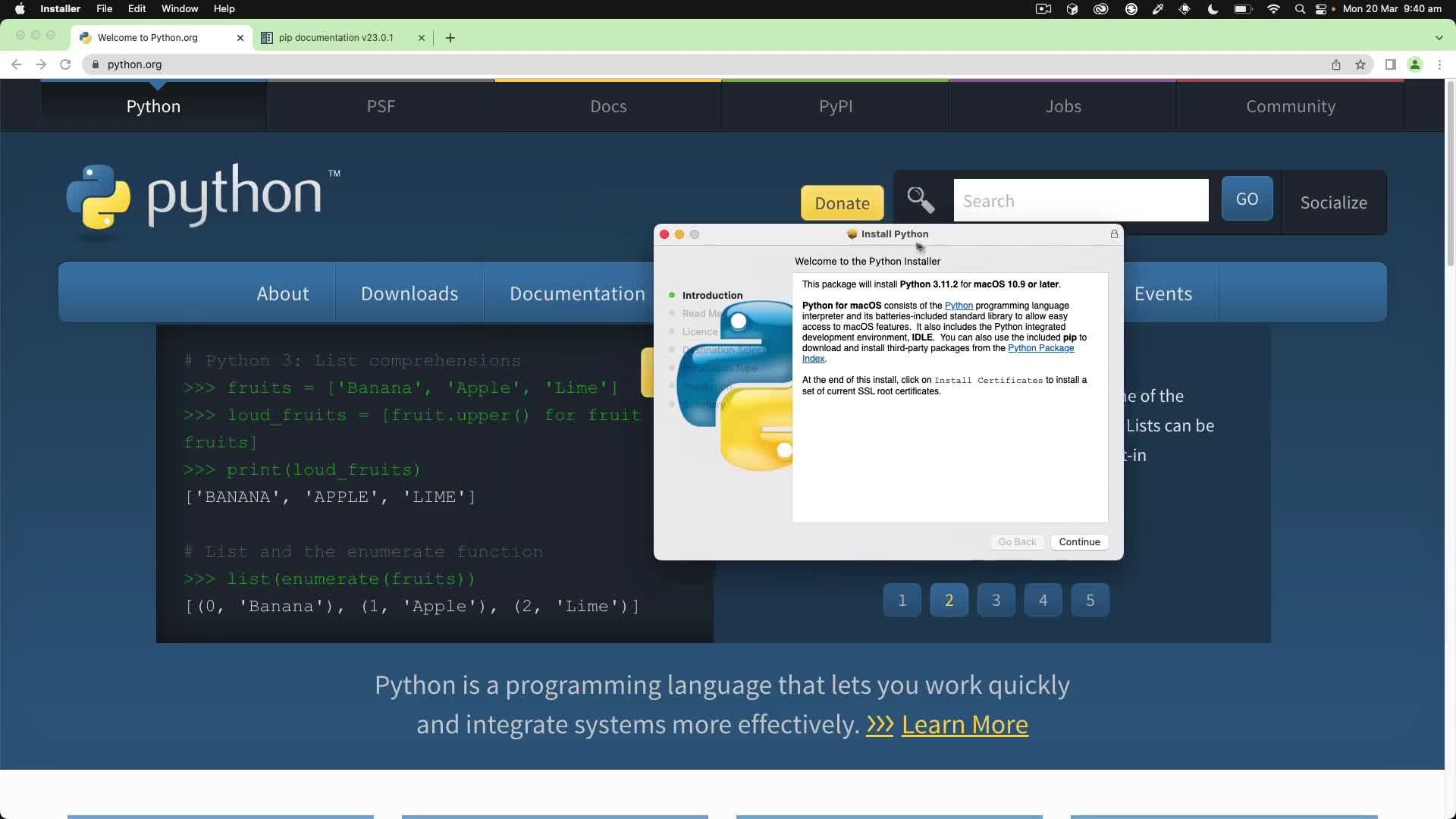Heads up! To view this whole video, sign in with your Treehouse account or enroll in your free 7-day trial. Sign In Enroll
Preview
Video Player
00:00
00:00
00:00
- 2x 2x
- 1.75x 1.75x
- 1.5x 1.5x
- 1.25x 1.25x
- 1.1x 1.1x
- 1x 1x
- 0.75x 0.75x
- 0.5x 0.5x
In this video, we’ll walk through how to install Python so it’s ready to use on your local machine.
Resources
Related Discussions
Have questions about this video? Start a discussion with the community and Treehouse staff.
Sign upRelated Discussions
Have questions about this video? Start a discussion with the community and Treehouse staff.
Sign up
The first step of installing Python is to
navigate to their website, python.org.
0:00
Python's website is home to its
extensive documentation, so
0:07
I recommend coming back whenever
you need some guidance.
0:10
For this workshop, we'll hover over
the Downloads tab to see what's available.
0:15
At the time of this recording,
the most recent Python version is 3.11.2.
0:20
Since you're viewing this from the future,
you will likely see a higher version.
0:27
The installation process
shouldn't have changed, but
0:31
if your screen looks drastically
different from mine,
0:34
be sure to check the teacher's notes for
this video.
0:38
Let's click on the button
here that says Python and
0:42
the version number and
a download will start.
0:45
This may take up to a few minutes
depending on your internet speed.
0:49
Once it's done,
open up your downloaded file and
0:54
it will bring up the Python installer.
0:58
You're welcome to read all the text
content here, but I will simply click
1:01
the Continue button for the first three
screens and then agree to the terms.
1:06
Once we're on the Installation Type
screen, we do have the option
1:13
to customize our installation, but
I will be doing a standard install.
1:17
Press the Install button and
you'll be prompted to enter your password.
1:22
Then we'll sit back and wait for
Python to be installed.
1:29
Once Python has been
successfully installed,
1:36
you'll see this screen and this folder.
1:40
Here, it says that Python needs
a set of SSL root certificates.
1:45
If that means nothing to you, don't worry.
1:50
All we have to do is double-click on the
Install Certificates icon in the finder
1:53
window that just opened.
1:57
So let's do that.
1:59
That was super fast.
2:02
And now Python is properly
installed on your computer.
2:04
We can close the terminal, the Finder
window and the Python installer and
2:09
move it to the bin.
2:14
Now let's check it out.
2:16
Open up your terminal using Spotlight.
2:18
If you're unfamiliar with Spotlight,
it's macOS's system-wide search feature.
2:20
You can search for files,
applications, and more from anywhere.
2:26
You can access it by clicking the
magnifying glass icon on the top right,
2:32
or simply pressing Cmd+Space.
2:38
Open up terminal, then type
python3 --version and press Enter.
2:42
You should see Python and your installed
version being printed to the terminal.
2:50
If that doesn't work, try python --version,
2:55
or, py --version.
3:00
Great job.
3:06
One more thing we should check for is pip,
which is Python's package manager.
3:08
As mentioned in the last video,
as you work more with Python,
3:15
you'll need to install third-party
packages to use along the way.
3:18
Pip is what allows you to manage these,
whether it's downloading,
3:23
installing, uninstalling, or upgrading.
3:28
Pip should be installed by
default since Python 3.3.
3:32
But let's check that it is ready to go.
3:36
Back in your terminal,
type pip3 --version and press Enter.
3:39
We can see that pip is indeed installed.
3:47
If that doesn't work,
try pip --version instead.
3:51
Congratulations, you've just
installed Python onto your computer.
3:57
You need to sign up for Treehouse in order to download course files.
Sign upYou need to sign up for Treehouse in order to set up Workspace
Sign up